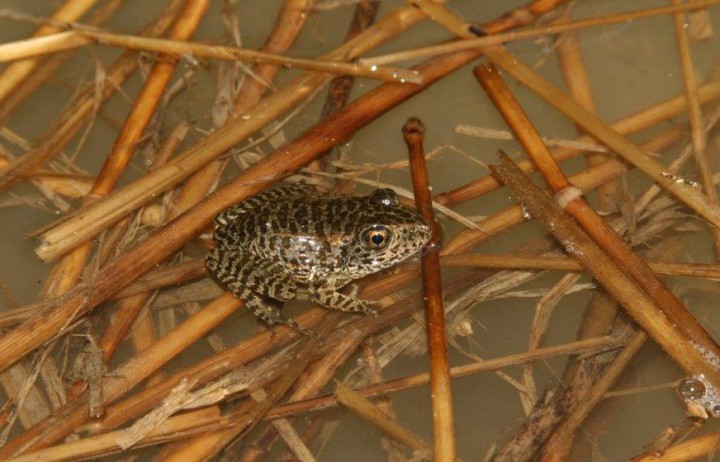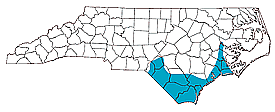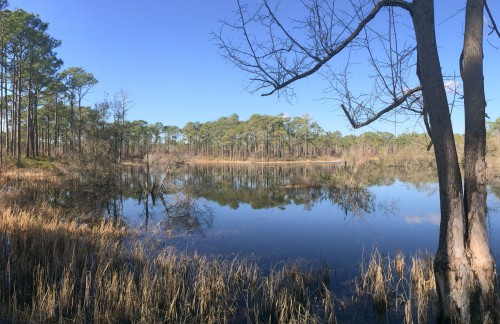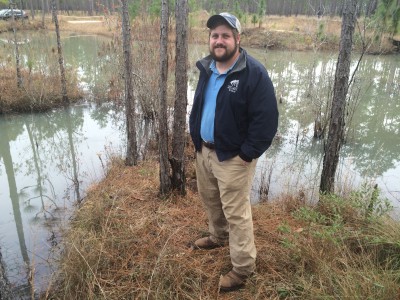
First of two parts.
KURE BEACH — Peering out from a mound of wet, dark moss in a small plastic tank at the N.C. Aquarium at Fort Fisher, a tiny frog raised in captivity for the entirety of its four-month life is now only hours away from being introduced to the outside world.
Supporter Spotlight
The little amphibian, a rare Carolina gopher frog, is one of several dozens of his kind to be given a head start on life in the protective care of captivity. The work is part of a conservation effort the aquarium launched five years ago in collaboration with the N.C. Wildlife Resource Commission. The program was renewed in 2015 and work continued through the fall to help the frogs survive the many threats they face in the wild. The commission recently gave the project a green light to continue this year. It’s a mission to save the species.

“Gopher frogs are probably one of the most imperiled frogs in North Carolina and probably one of the most imperiled vertebrates,” said Jeff Hall, a biologist with the commission. He said the frogs’ rarity has long been known and their listing as a threatened species under the Endangered Species Act goes back to about 1995.
At least 30 separate populations of Carolina gopher frogs were known to exist years ago, maybe as many as 50. Today, only six to eight locations are known, but the search is on for more. Their range is mainly in southeastern North Carolina but also extends north to Carteret, Craven and Beaufort counties and west as far as about Richmond County.
An ideal habitat for Carolina gopher frogs is an unshaded pond surrounded by at least four to five acres of longleaf pines and wiregrass.
“There are not many places like that left,” Hall said. “We try to do everything we can to save these remaining populations so we don’t lose this animal.” That includes captive raising or “head-starting,” habitat restoration and restoring or creating wetlands.
Supporter Spotlight
“During the past decade we ramped up our efforts to learn about the frog and correct things that have made it so rare. Head-starting is another tool in our toolbox to protect the species,” Hall said.

The program is intended to give a head start to metamorphs, the stage when tadpoles develop legs and lungs, absorb their tales and are well on their way to becoming frogs. Only about 15 percent of gopher frogs are estimated to survive the roughly 12-week period from egg stage to tadpole to metamorph in the wild but in captivity their odds are greatly improved, potentially up to about 85 percent.
“We’re really pleased to partner with the aquarium on this effort,” Hall said. “They approached us and said, “We know this is a problem, how can we help out?’”
The N.C. Aquarium Society provided funding for the gopher frog conservation work, including money for a conservation-technician position. The aquarium is also a partner in an organization called SAFE: Saving Animals from Extinction.
In the sandhills region, the N.C. Zoo has also offered to lend a hand. The U.S. Forest Service and the U.S. Defense Department have also helped, allowing monitoring to take place on their lands.
“That’s the key in all of this work, the partnerships,” Hall said.
Frogs That Look Like Toads
Carolina gopher frogs look much like a toad, warts and all. They have rather large heads and a chunky build. They range in color from pale gray or tan to dark, almost black, with spots. Their bellies are mottled and there’s often light orange or yellow coloring inside their thighs.
The frogs are so called because the adults are said to use the burrows of gopher tortoises as hiding places in parts of the Deep South, but there are no gopher tortoises in North Carolina. Here, the frogs are usually found hiding in stump holes, root tunnels and burrows left by mammals and crayfish.
The frogs’ breeding season typically begins around this time of year and mating usually continues through about mid-April. A female gopher frog typically produces only one egg mass a year, laying them just below the surface in shallow ponds that lack fish and other predators, although dragonfly nymphs, turtles and diving beetles sometimes eat the eggs. Each mass can contain thousands of eggs that begin to develop once the water gets warmer.

The frogs are known to live at sites near the Military Ocean Terminal Sunny Point in Brunswick County, the Holly Shelter Game Land in Pender County, the Sandhills Game Land in Richmond County, Fort Fisher in New Hanover County and the area around Patsy Pond in the Croatan National Forest in Carteret County.
There may also be some privately owned undeveloped lands where the frogs are well established, but overall, their habitats are disappearing and human activity is a constant threat.
Nate Akers, the conservation and research technician at the N.C. Aquarium at Fort Fisher and manager of the gopher frog project, along with others on his team, searched for those special places early last year, venturing deep into the pine forests at night to listen for the distinctive, deep, throaty, cartoonish snoring sound that is the male gopher frog’s mating call.
“That’s what gopher frogs sound like but just because they’re calling doesn’t mean they’re getting anything,” Akers said, adding that as an avid outdoorsman who hunts and fishes for most of his meals, he especially enjoys the deep-woods adventures. “This is a really cool part of the job, coming out here at nighttime, listening for calls, sitting on stumps.”
Hall said automated “frog loggers,” recording devices mounted in suspected habitats, are also used.
“You can program it to record at whatever intervals you want, such as five to 10 minutes every hour on the hour starting at dusk,” Hall said. “There’s only so many places we can go and be on any one night and we’re always trying to find new places.”
The teams then return again later during daylight to the locations where mating sounds were heard to look for and count the egg masses, which can be found clinging to submerged grasses in shallow ponds. About 10 percent of the total number of egg masses counted are collected and taken to the aquarium, where a frog nursery is set up.
The Frog Nursery
Collected egg masses are each kept separately to allow the team to measure how each mass develops. This also keeps populations from different areas from comingling and it helps guard against working in opposition to the process of natural selection. That’s one of the big concerns with providing a head start for the frogs in captivity: allowing bad genes to reproduce, Akers said.

Each group of eggs is carefully cared for until they hatch and can be placed in 10 large holding pods at the aquarium. The amphibians are frequently fed and grow in these pods from larval stages to young adult frogs.
About 100 tadpoles were placed in each fiberglass tank in 2015, but the tank for the Sunny Point military terminal had only about 83 last year. “There wasn’t as much going on out there,” Akers explained.
One trip to gather eggs at the two pond habitats in Holly Shelter produced only 12 egg masses. There are about eight ponds at Sunny Point and only eight egg masses were found there.
“These guys are not doing particularly well,” Akers said.
One exception is the Patsy Pond site, where 26 egg masses were found during one visit. Perhaps the “brightest spot” among gopher frog habitats is at Camp Lejeune, Akers said. The Marine Corps base has about 23 ponds that are teeming with breeding adults.
“It appears that population is the only one that’s probably going to persist without any help. All the others need some help,” Akers said.
The number of gopher frog eggs in known habitats is a good indication of their health and the status of the larger ecosystem. Amphibians are really good ecological indicators, Akers said.
“If it’s good enough for gopher frogs it’s usually good enough for everything else,” he said.
Hall agrees. He said multiple species depend on the same types of habitats. Wetlands-restoration work has led to increases in the numbers of species found at project sites.
“A lot of work we’re doing has side benefits for other species,” Hall said.
Tuesday: Return to the wild








